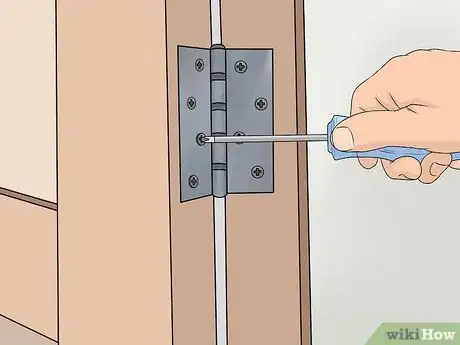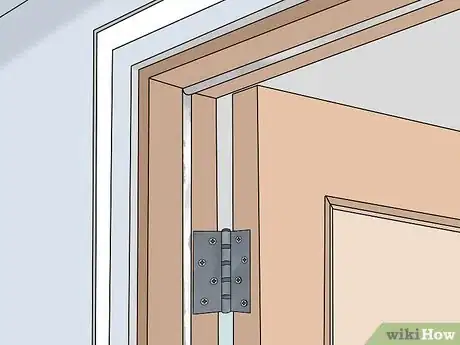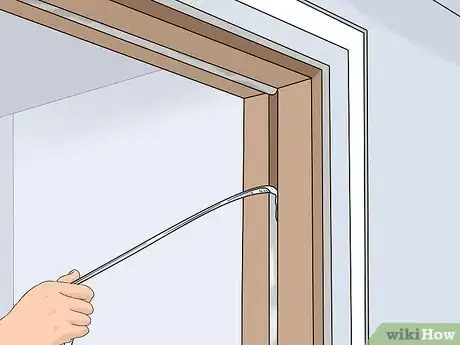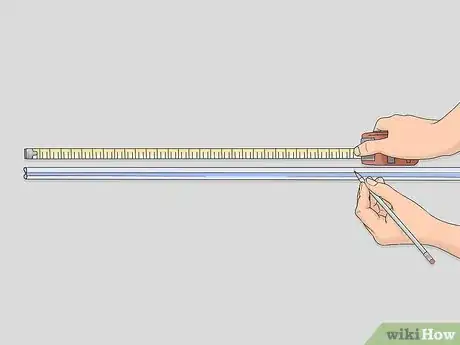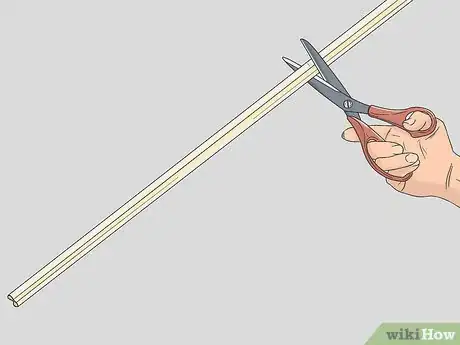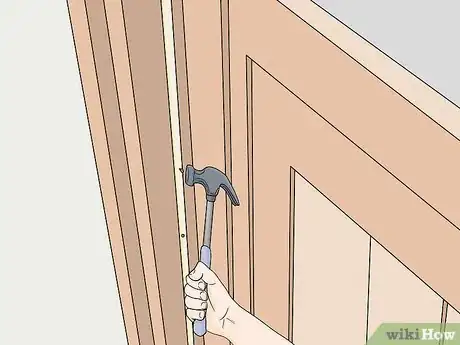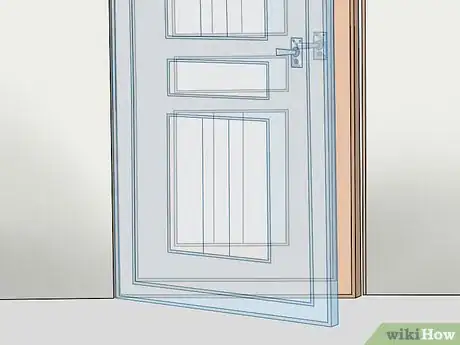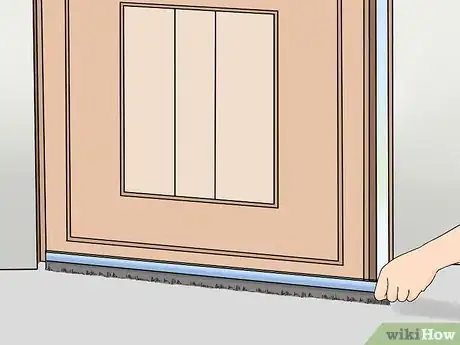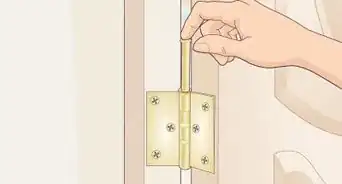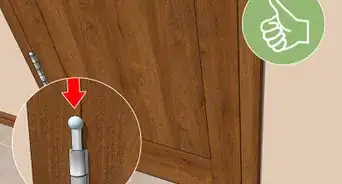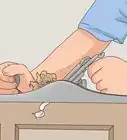This article was co-authored by Jacob Pischer. Jacob Pischer is a Home Improvement Specialist and the Owner of Helpful Badger, a home repair service in Portland, OR. With over four years of experience, Jacob specializes in a variety of handyman services including pressure washing, cleaning gutters, repairing drywall, fixing leaky plumbing fixtures, and repairing broken doors. Jacob studied at Madison Area Technical College and has a background in real estate investment.
There are 11 references cited in this article, which can be found at the bottom of the page.
This article has been viewed 126,204 times.
Gaps around your door allow air to pass through, creating drafts in your home. This will reduce the efficiency of your heating and cooling and can make your home less comfortable to be in. However, it is quick and easy to seal a door. To do it, determine where your air leaks are and cover them with weather stripping.[1] After you apply the weather stripping, you simply need to ensure that your door can still open and close easily before enjoying the benefits of your newly sealed door.
Steps
Checking and Cleaning the Doorway
-
1Tighten the hinges on your door. Lift the door by the doorknob. If you can move it upward, then the hinges are likely loose. Use a screwdriver to tighten the screws holding the hinges in place.[2]
- Some drafts are caused by the door shifting due to loose hinges. Because of this, before you seal the edges of your door, take a few minutes to tighten all of the hardware.
- If the hinge screws spin but won't tighten, it means that the wood in the hole is stripped out. You will need to replace the screws with wider or longer screws so that they can dig into wood that is not damaged. You may also need to fill the holes with wood plugs and re-drive the new screws into those plugs if there is a lot of wood damage.
Tip: Similarly, if the doorknob itself moves when you lift it, you should tighten or replace it.
-
2Check the state of the old weather stripping. If your door had weather stripping previously installed, it might be damaged or deformed. Check it by running your hand around the perimeter of the door while the door is closed. Feel for air coming in between the door and the frame. Mark the areas where you feel air coming in with a light pencil mark or a piece of painter’s tape.
- If you can feel a draft while checking areas that already have weather stripping, you will need to remove the old weather stripping and replace it with a new seal.[3]
Advertisement -
3Clean the areas that need to be sealed. Remove old weather stripping that is broken or ineffective by peeling or sliding it away.[4] Then use a damp rag to wipe away any visible dirt and debris from the door frame and the edges of the door itself. This will help you attach your new weather stripping securely.[5]
- Drag the edge of a paint scraper along the top, bottom, and sides of the door and door frame to remove any stuck-on debris from these surfaces.[6]
- Also clean the threshold, which is the bottom of the door frame. If there are grooves along the threshold, run a nail through the grooves to scrape away any gunk that has gotten lodged in there. Then run a lightly damp rag along the threshold and door frame to ensure that the surfaces are clean.
-
4Buy new weather stripping at a home improvement or hardware store. There are several different types of weather stripping available, so you'll need to decide which one you wish to use.[7] For the top and sides of your door, wrapped foam weather stripping is durable and works well with gaps of various sizes. Weather stripping with a wooden shell is durable yet easier to work with than metal weather stripping, so it makes a good choice for someone who has no prior experience sealing doors. For the door sweep, consider using a metal door sweep with a flexible vinyl flap for greater durability.[8]
- A metal door sweep with a flexible vinyl flap is also fairly easy to install, as the metal piece is screwed down and then the vinyl is inserted into it. More advanced options include storm-proof seals and roller door seals, such as brush or auto-lift vinyl seals that attach to the bottom of roller doors.[9]
- If purchasing a weather stripping kit, note that most kits only contain weatherstripping for the top and sides of your door. You will need to purchase a separate door sweep.
- Rigid door sweeps will not work if the carpet is higher or even with the threshold. When rigid door sweeps won't work, use flexible bulb weather stripping made of vinyl. This attaches to the threshold right under the door.[10]
- If possible, buy a couple of different thicknesses of weatherstripping and try it out to make sure that the door closes well. When using the wrong size, the door will simply bounce back.[11]
Measuring the Door
-
1Measure the top and sides of the door frame. Close the door and measure along the top of the frame using a tape measure. With the door still closed, measure along both sides of the frame with a tape measure.[12]
- Note that your measurements for the top and sides of the door will need to be made along the door frame and not the door itself.
- To achieve a tight seal, you will need to measure cut pieces of weather stripping that are tailor fit to each side, which means that you will need to know the precise length of each side.
Tip: You should measure both sides separately. Both sides will usually be the same length, but errors in construction are common enough, so there can be some slight variations in length.
-
2Measure the bottom of the door. Open the door, then measure the bottom of the door using a tape measure. Unlike the measurements you took for the top and side seals, you will need to measure for the bottom seal by measuring the bottom of the door itself.[13]
- Make sure that you face the inside of the door as you take this measurement. This is the surface that you will be applying weather stripping onto.
-
3Mark those measurements on the weather stripping. Use a tape measure to measure out each length onto the weather stripping for the top and sides of the door that you purchased. Mark the length of the bottom of the door on the door sweep weather stripping that you purchased.[14]
- Mark each length using a sharp pencil or marker. Make sure that each line you draw is clear and sharp.
- When using a weather stripping kit, you will have two long pieces for the sides and one short piece for the top. Make sure to draw your top measurement on the short piece and your side measurements on the long pieces.
-
4Trim the weather stripping down to size. Cut the weather stripping at the marks you just measured out. Keep your cuts as clean and even as possible to ensure a tight seal. You'll also need to make sure that the ends of the top piece are angles and one end of each side piece is angled to fit into the top piece of weather stripping. You do not need to angle the bottom end of your side pieces.[15]
- The foam and vinyl portions can be cut using sharp scissors, but you will need a hacksaw or similar tool to cut any metal or wood portions.
- Hold the metal or wood still with one hand and saw through it with the other. Saw slowly so that you cut it in a straight line.
Installing Weather Stripping
-
1Tack the top piece of weather stripping in place. Step inside, close the door, and then position the top piece of weather stripping along the top of your door frame. Loosely nail it into place. Only hammer the nails in enough to hold the weather stripping in place.[16]
- Do not finish driving the nails until you add the side pieces.
- This seal must be installed along the door frame and not onto the door itself.
- Use 1-1/2 inch (3.75 cm) nails. Place the nails 2 inches (5 cm) in from either side to prevent splitting. Nails should also be 12 inches (30.5 cm) apart.
Tip: When you place the weather stripping, the foam should completely fill in the gap at the top of the frame. It should only compress slightly, however, and not too tightly. Tight compression may prevent the door from latching.
-
2Tack your side pieces into place. Position the side pieces of weather stripping along the sides of your door frame. As with the top piece, your side pieces will need to fit onto the door frame instead of the actual door and the foam should fill the gap around the door. Place each side piece along the sides of the door frame and tack them into place with a hammer and nails.[17]
- If the top angle does not fit into the top piece of weather stripping, file it down. You can use a metal file, sandpaper, or sanding belt to fine-tune these top angles.
- Make small adjustments and check the fit until you reach the proper angle.
- As with the top piece of weather stripping, use 1-1/2 inch nails and place them 2 inches (5 cm) from either end. Nails should be spaced 12 inches (30.5 cm) apart from one another.
-
3Test the seal. Open and close the door several times to make sure that the weather stripping seals properly. Feel the areas you marked that had air flow to ensure that the weather stripping is doing its job. The weather stripping must completely seal against the door as it closes, and the door must be able to latch and lock.
- Remove and adjust the placement of your weather stripping as needed to achieve a proper seal
-
4Set the nails to hold the weather stripping in place. Finish hammering in the nails once the weather stripping along the top and sides of the door seals properly. Check the seal once more after you finish hammering in the nails. Open and close the door to make sure that the seal still holds.[18]
-
5Determine the proper position of the door sweep on the door. Place the door sweep along the bottom edge of the inside of the door, but do not screw or nail it into place yet. The flexible portion of the door sweep must touch the top of the threshold, but it should not rub against it too tightly.[19]
- Metal door sweeps will already have screw holes in them. Mark the position of these holes onto your door using a pencil or marker. Remove the door sweep temporarily, then drill pilot holes into these marked portions.
- Note that vinyl door sweeps are installed on the threshold instead of the door, however. Align one end of the strip with one end of the threshold. Using your hands, firmly press the flanges, which are the edges of the strip, into the grooves of the threshold.[20]
-
6Attach the door sweep.[21] Push the door sweep against the bottom threshold of the door. Insert the screws into your previously drilled pilot holes. Use a screwdriver to screw the sweep in place.[22]
- When using a vinyl door sweep, place a wood tapping block over the weather stripping. Strike the block with your hammer to drive the flanges of the weatherstripping deep into the grooves of the threshold.
-
7Test the seal once more. Open and close the door several times to test the bottom seal. Once the sides, top, and bottom portions of weatherstripping are properly installed, the process is complete. Your door should now be sealed.[23]
Expert Q&A
Did you know you can get premium answers for this article?
Unlock premium answers by supporting wikiHow
-
QuestionWhat materials do you need to seal an exterior door?
 Barry ZakarBarry Zakar is a professional handyman and the founder of Little Red Truck Home Services based in the San Francisco Bay Area. With over ten years of experience, Barry specializes in a variety of carpentry projects. He is skilled at constructing decks, railings, fences, gates, and various pieces of furniture. Barry also holds his MBA from John F. Kennedy University.
Barry ZakarBarry Zakar is a professional handyman and the founder of Little Red Truck Home Services based in the San Francisco Bay Area. With over ten years of experience, Barry specializes in a variety of carpentry projects. He is skilled at constructing decks, railings, fences, gates, and various pieces of furniture. Barry also holds his MBA from John F. Kennedy University.
Handyman
Things You'll Need
- Damp rag
- Paint scraper, if necessary
- Weatherstripping
- Door sweep
- Hammer
- 1-1/2 inch (3.75 cm) nails
- 1-1/2 inch (3.75 cm) screws
- Drill
- Screwdriver
- Hacksaw or coping saw
- Sharp scissors
- Sand paper, metal file, or sanding belt
- Measuring tape
- Pencil or marker
References
- ↑ Barry Zakar. Handyman. Expert Interview. 20 August 2020.
- ↑ https://www.familyhandyman.com/doors/door-weather-stripping/
- ↑ Barry Zakar. Handyman. Expert Interview. 20 August 2020.
- ↑ Jacob Pischer. Home Improvement Specialist. Expert Interview. 4 September 2020.
- ↑ https://www.thisoldhouse.com/how-to/how-to-make-your-doors-draft-free-weatherstripping
- ↑ Jacob Pischer. Home Improvement Specialist. Expert Interview. 4 September 2020.
- ↑ Jacob Pischer. Home Improvement Specialist. Expert Interview. 4 September 2020.
- ↑ https://www.familyhandyman.com/doors/door-weather-stripping/
- ↑ https://www.youtube.com/watch?v=qj9accrLuh0
- ↑ https://extension.umaine.edu/publications/7215e/
- ↑ Jacob Pischer. Home Improvement Specialist. Expert Interview. 4 September 2020.
- ↑ https://www.familyhandyman.com/doors/door-weather-stripping/
- ↑ https://www.thisoldhouse.com/how-to/how-to-make-your-doors-draft-free-weatherstripping
- ↑ https://www.bobvila.com/articles/door-weather-stripping/
- ↑ https://www.familyhandyman.com/doors/door-weather-stripping/
- ↑ http://www.familyhandyman.com/doors/weatherstripping-doors/view-all
- ↑ http://www.familyhandyman.com/doors/weatherstripping-doors/view-all
- ↑ https://www.thisoldhouse.com/how-to/how-to-make-your-doors-draft-free-weatherstripping
- ↑ https://www.todayshomeowner.com/video/installing-a-door-sweep-on-an-entry-door/
- ↑ https://www.todayshomeowner.com/video/how-to-replace-an-entry-door-threshold/
- ↑ Barry Zakar. Handyman. Expert Interview. 20 August 2020.
- ↑ https://www.thisoldhouse.com/how-to/how-to-make-your-doors-draft-free-weatherstripping
- ↑ https://www.familyhandyman.com/doors/door-weather-stripping/
- ↑ https://www.energy.gov/energysaver/weatherize/air-sealing-your-home/weatherstripping
About This Article
If there are any gaps around your door, you can easily seal them with weather stripping to eliminate drafts. If you have old weather stripping that’s damaged, you’ll need to remove this first. Then, cut your new weather stripping to the length of your door frame’s top and sides. When you attach it to your door frame, only hammer the nails in lightly at first. That way, you can check that the door closes properly before you finish hammering in the nails. If there’s a gap at the bottom of your door, attach a door sweep to stop any air getting through. For more tips, including how to tighten the hinges on your door, read on!

